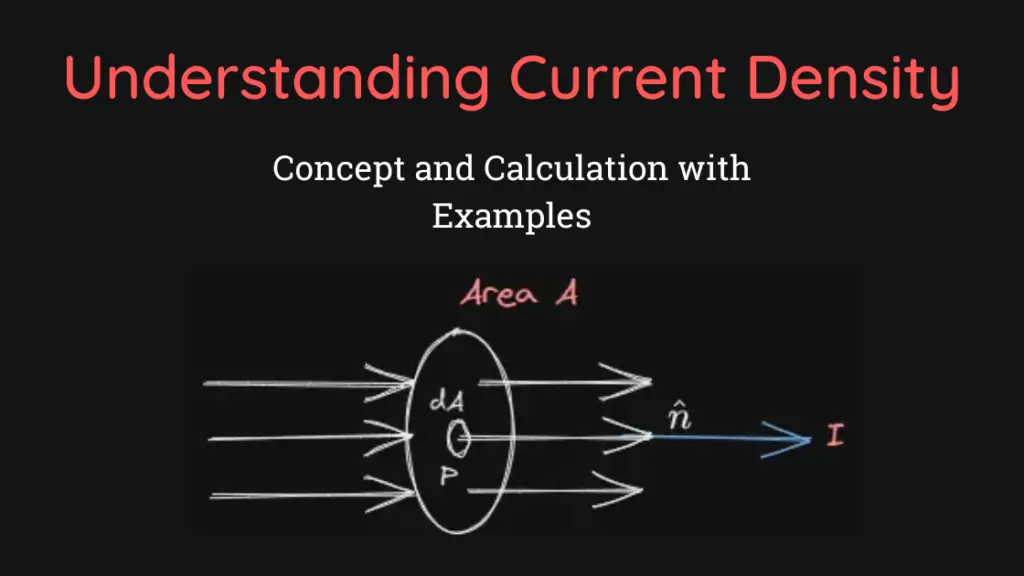
In this article, we are going to learn about the concept of current density. Current density is a fundamental concept we must know when we are studying electromagnetism or electric circuits.
Key Takeaways
- Definition and Significance: Current density is a measure of electric current flowing per unit cross-sectional area. It is a vital concept in physics, especially in electromagnetism and electronics, as it helps understand how current is distributed over a particular area.
- Mathematical Representation: Current density (J) is calculated by the formula J = I/A, where I is current and A is the cross-sectional area of the conductor. It’s important to remember that current density is a vector quantity, unlike current which is a scalar quantity.
- Units and Dimensions: The SI unit of current density is Ampere per square meter (A/m²), indicating its nature as current flow per unit area. Its dimensions are [A M^0 L^-2 T^0], further reflecting its definition and physical nature.
Sure, I’d be glad to explain this topic to you. Let’s start with the basic definition, then move on to the mathematical formula, and finally, a couple of examples.
Definition and Concept of Current Density
Definition of current density
Current density is a measure of the amount of electric current (charge per unit of time) passing through a specific cross-sectional area in a unit of time. It’s a vector quantity, meaning it has both magnitude and direction.
Concept
The current density helps to understand how the current is distributed over a particular area. In situations where the current is uniformly distributed over the cross-sectional area, the current density remains constant. However, in practical situations, due to certain factors like material properties and geometry, current distribution may not be uniform and hence current density may vary across the cross-section.
Mathematical Representation of Current Density
The formula of current density
The formula for current density (J) is given by:
J = I/Awhere:
Jis the current density, measured in Amperes per square meter (A/m²),Iis the current through the conductor, measured in Amperes (A),Ais the cross-sectional area of the conductor, measured in square meters (m²).
Vector Nature of Current Density
Current density is a vector quantity, and its direction is always in the direction of the flow of positive charge. In differential form, it can be represented as:
$\vec{J} = \frac{dI}{dA}$
where $\vec{J}$ is the current density, $dI$ is the differential current and $dA$ is the differential area vector. The direction of $dA$ is normal for the area.
Units and Dimensions of Current Density
Units of Current Density
The SI unit of current density is Amperes per square meter (A/m²). This unit can be understood by looking at the formula of current density, which is current divided by area. Since the current is measured in Amperes and area is measured in square meters, the unit of current density becomes Amperes per square meter.
Dimensions of Current Density
The dimensional formula of current density can be derived from its definition.
We know that current density (J) = current (I) / area (A).
The dimension of current (I) is [A] (Amperes) and the dimension of area (A) is $[M^0 L^2 T^0]$ (length squared). Therefore, the dimensions of current density (J) are given by the dimensions of current divided by the dimensions of the area.
So, the dimensional formula of current density is:
$$[J] = [I] / [A] = [A] / [M^0 L^2 T^0] = [A M^0 L^-2 T^0]$$
Difference between current and current density
| Attribute | Electric Current | Current Density |
|---|---|---|
| Description | Electric current is defined as the rate at which charge is flowing. | Current density is the measure of current flowing across a unit area of a conductor. |
| Equation | Electric current (I) can be calculated using the formula I = Q/t, where Q is the electric charge and t is time. | Current density (J) can be determined using the equation J = I/A, where I is the electric current and A is the area of cross-section. |
| SI Unit | The standard unit for electric current is the Ampere (A). | For current density, the standard unit is Ampere per square meter (A/m²). |
| Dimensional Formula | The dimensional representation for current is $[A]$. | Current density has a dimensional formula of $[A M^0 L^{-2} T^0]$. |
| Character | Current is a scalar quantity. | Current density, on the other hand, is a vector quantity. |
| Dependence | The electric current remains constant across a conductor at any given moment, irrespective of the cross-sectional area. | The current density may vary across the cross-sectional area of a conductor due to the potential for non-uniform distribution of current. |
Examples and Problems
Example 1
Suppose a wire has a uniform current of 5 Amperes flowing through it, and the cross-sectional area of the wire is $2 \times 10^{-6} m^2$. What is the current density?
Solution:
Given:
- I = 5 A
- A = 2 x 10^-6 m²
We can use the formula to find J:
$J = I/A = \frac{5A}{ 2\times 10^{-6} m^2} = 2.5 \times 10^6 A/m^2$
Example 2
A conductor has a current of 10 Amperes flowing through it. The cross-sectional area over which the current is flowing is $1 \times 10^{-4} m^2$. Calculate the current density.
Solution:
Given:
- $I = 10 A$
- $A = 1 \times 10^{-4} m^2$
We can use the formula to find J:
$J = \frac{I}{A} = \frac{10A}{1\times 10^{-4} m^2} = 1\times 10^5 A/m^2$
